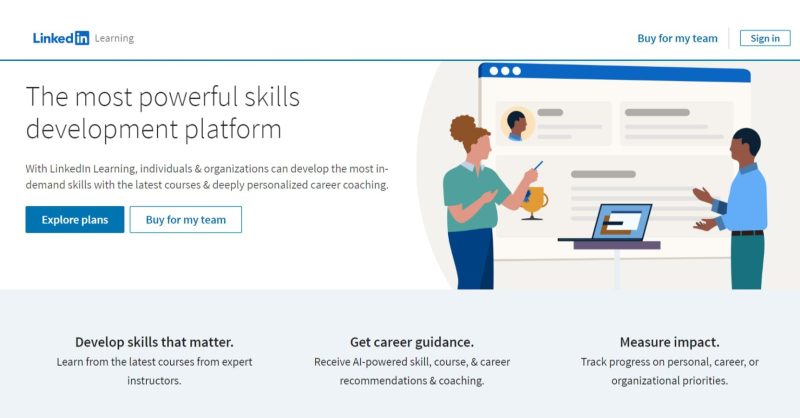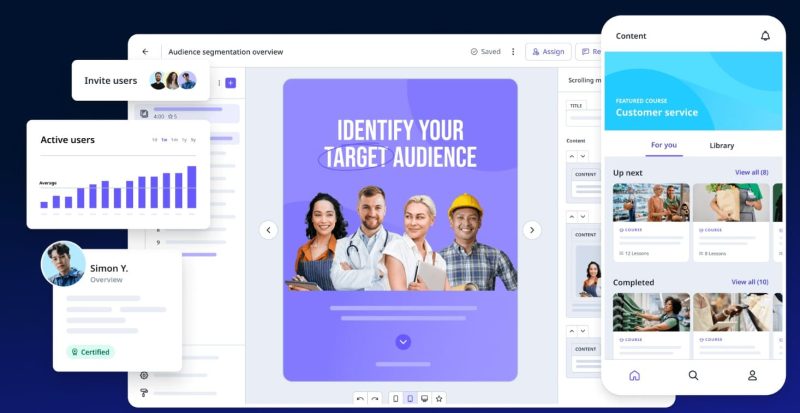Microlearning – table of contents:
What is microlearning?
Microlearning is an innovative method of learning and professional development that involves acquiring knowledge in small, easily digestible doses. With microlearning, employees can learn new things efficiently, flexibly, and cost-effectively throughout their entire careers.
It can be defined as learning through short, few-minute training modules. These could include, for example:
- short instructional videos and video lectures,
- interactive games and quizzes,
- infographics and articles,
- knowledge exchange on social media.
Microlearning follows a few simple principles:
- It gives information in small bits.
- It is tailored to specific training goals.
- It allows learning anytime, anywhere.
- It engages learners through interaction.
The cool thing about it is that it doesn’t require special systems or expensive gear. Simple tools like smartphones, laptops, and social media, which you already use daily, are enough.
However, what exactly are the advantages of microlearning in business, and why should you consider using it in your company?
7 reasons why you’ll love microlearning in your company
Here are seven reasons why many companies prefer using this way of sharing knowledge:
- Short and to the point. Say goodbye to those dull, lengthy training sessions. It delivers knowledge in short, 15-minute modules that are easy to fit into a busy schedule. It’s also easy to select modules with topics that are relevant to your company’s needs and skip the rest,
- Fast and effective learning. Thanks to its format, the brain absorbs information more easily. Studies have shown that microlearning increases knowledge retention by up to 80%, compared to traditional training methods (source: Brandon Hall Group),
- Motivation and engagement. Short formats and interactive stuff, like quizzes or gamified elements, keep things interesting and boost motivation.
- Available on demand. It doesn’t require booking training rooms or setting specific hours. Employees can learn at any time and place, using any device.
- Effectiveness in various areas. It works well for both product training and soft skills development, such as communication or time management,
- Lower training costs. Shorter modules and fewer resources make it a cheaper way to train employees than traditional training.
- Improved business performance. Skilled employees make fewer mistakes, work better, and help the company succeed.
How to create a microlearning strategy?
To implement microlearning in a company, you first need to develop a cohesive strategy. Here are the key points to keep in mind:
- Tie your training goals with the company’s business objectives. Consider what skills you want to develop in your employees to ensure they align with the company’s goals.
- Identify training needs. Figure out what each employee needs to learn, at what level, and why. Decide if you want to use ready-made courses or create custom materials for your company, either on your own or with specialist help.
- Break the material into chunks. To make it effective, break down the content into short, bite-sized modules that focus on specific learning goals.
- Create or select engaging content. Choose appropriate methods and channels for content distribution – videos, games, social media, etc. Ensure high quality and engaging materials. Also, establish a space for interaction, knowledge sharing, and teamwork, such as a social media group.
- Set goals. Determine how much time and how often employees should learn. In it, just 3-5 minutes a day can be enough.
- Measure the effects. Track progress consistently and collect data on how well things are working. Use this information to adjust and improve your company’s training strategy.

Source: LinkedIn Learning (https://learning.linkedin.com/)
How to implement microlearning in your company?
You don’t have to revolutionize the entire learning process in the company to implement it. Take small steps. Begin with a pilot—try out short videos on a specific topic or skill. See how it goes and adjust as needed.
Use mobile technologies to integrate learning with daily tasks. For example, you can introduce short training modules during the team’s morning meeting. Make it effective by blending formal and informal training. Mix traditional lectures with hands-on workshops and practical microlearning activities.
It’s also worth supporting the implementation of it in the company by using dedicated platforms:
- EdApp (https://www.edapp.com/) – EdApp is a microlearning platform that provides tools for creating and delivering educational content. This platform is accessible on various devices, including smartphones and tablets. EdApp also offers the ability to analyze results, reporting, and many other tools useful for creating your own microlearning content.
- Udemy (https://www.udemy.com/) – Udemy takes a different approach. While you can create your own courses, the standout feature is the wide range of pre-made educational content at affordable prices. With over 210,000 courses in areas like development, business, design, and marketing, you can access them through a monthly subscription or pay for each course separately.
- LinkedIn Learning (https://learning.linkedin.com/) – the platform formerly known as Lynda, now called LinkedIn Learning, offers over 20,000 courses in business, technology, and creativity. LinkedIn Learning also provides the option to pay for each course individually or through a monthly subscription. However, the costs are slightly higher compared to Udemy.
There are plenty of microlearning platforms available. Choose the one that fits your interests and budget.

Source: EdApp (https://www.edapp.com/)
What effects can microlearning bring?
Introducing microlearning in line with your company’s goals can bring several advantages. Here are some of them:
- Lower costs. Lots of microlearning content is free, and even paid courses are much cheaper than traditional training.
- Shorter training time. By eliminating unnecessary elements, personalizing content, and allowing participants to choose the learning format that suits them best, training can be significantly shorter.
- Increased training effectiveness. With better information retention, the time and effort invested in acquiring knowledge translate into improved skills for employees.
- Reduced employee turnover. Employees build skills important for the company and ones they personally choose. This helps them grow with the company and feel more satisfied at work.
Summary
Make microlearning enjoyable. Explore different courses, find topics that benefit your company and spark your employees’ passion for learning. Remember, microlearning doesn’t have to replace traditional training methods; it complements them. Use it to review, prepare for sessions, or as inspiration for further learning.
In summary, microlearning is a modern and effective way to develop skills at work. It’s a simple and cost-effective way to boost your employees’ knowledge, leading to better business results for your company.

If you like our content, join our busy bees community on Facebook, Twitter, LinkedIn, Instagram, YouTube, Pinterest, TikTok.
Author: Robert Whitney
JavaScript expert and instructor who coaches IT departments. His main goal is to up-level team productivity by teaching others how to effectively cooperate while coding.
AI in business:
- Threats and opportunities of AI in business (part 1)
- Threats and opportunities of AI in business (part 2)
- AI applications in business - overview
- AI-assisted text chatbots
- Business NLP today and tomorrow
- The role of AI in business decision-making
- Scheduling social media posts. How can AI help?
- Automated social media posts
- New services and products operating with AI
- What are the weaknesses of my business idea? A brainstorming session with ChatGPT
- Using ChatGPT in business
- Synthetic actors. Top 3 AI video generators
- 3 useful AI graphic design tools. Generative AI in business
- 3 awesome AI writers you must try out today
- Exploring the power of AI in music creation
- Navigating new business opportunities with ChatGPT-4
- AI tools for the manager
- 6 awesome ChatGTP plugins that will make your life easier
- 3 grafików AI. Generatywna sztuczna inteligencja dla biznesu
- What is the future of AI according to McKinsey Global Institute?
- Artificial intelligence in business - Introduction
- What is NLP, or natural language processing in business
- Automatic document processing
- Google Translate vs DeepL. 5 applications of machine translation for business
- The operation and business applications of voicebots
- Virtual assistant technology, or how to talk to AI?
- What is Business Intelligence?
- Will artificial intelligence replace business analysts?
- How can artificial intelligence help with BPM?
- AI and social media – what do they say about us?
- Artificial intelligence in content management
- Creative AI of today and tomorrow
- Multimodal AI and its applications in business
- New interactions. How is AI changing the way we operate devices?
- RPA and APIs in a digital company
- The future job market and upcoming professions
- AI in EdTech. 3 examples of companies that used the potential of artificial intelligence
- Artificial intelligence and the environment. 3 AI solutions to help you build a sustainable business
- AI content detectors. Are they worth it?
- ChatGPT vs Bard vs Bing. Which AI chatbot is leading the race?
- Is chatbot AI a competitor to Google search?
- Effective ChatGPT Prompts for HR and Recruitment
- Prompt engineering. What does a prompt engineer do?
- AI Mockup generator. Top 4 tools
- AI and what else? Top technology trends for business in 2024
- AI and business ethics. Why you should invest in ethical solutions
- Meta AI. What should you know about Facebook and Instagram's AI-supported features?
- AI regulation. What do you need to know as an entrepreneur?
- 5 new uses of AI in business
- AI products and projects - how are they different from others?
- AI-assisted process automation. Where to start?
- How do you match an AI solution to a business problem?
- AI as an expert on your team
- AI team vs. division of roles
- How to choose a career field in AI?
- Is it always worth it to add artificial intelligence to the product development process?
- AI in HR: How recruitment automation affects HR and team development
- 6 most interesting AI tools in 2023
- 6 biggest business mishaps caused by AI
- What is the company's AI maturity analysis?
- AI for B2B personalization
- ChatGPT use cases. 18 examples of how to improve your business with ChatGPT in 2024
- Microlearning. A quick way to get new skills
- The most interesting AI implementations in companies in 2024
- What do artificial intelligence specialists do?
- What challenges does the AI project bring?
- Top 8 AI tools for business in 2024
- AI in CRM. What does AI change in CRM tools?
- The UE AI Act. How does Europe regulate the use of artificial intelligence
- Sora. How will realistic videos from OpenAI change business?
- Top 7 AI website builders
- No-code tools and AI innovations
- How much does using AI increase the productivity of your team?
- How to use ChatGTP for market research?
- How to broaden the reach of your AI marketing campaign?
- "We are all developers". How can citizen developers help your company?
- AI in transportation and logistics
- What business pain points can AI fix?
- Artificial intelligence in the media
- AI in banking and finance. Stripe, Monzo, and Grab
- AI in the travel industry
- How AI is fostering the birth of new technologies
- The revolution of AI in social media
- AI in e-commerce. Overview of global leaders
- Top 4 AI image creation tools
- Top 5 AI tools for data analysis
- AI strategy in your company - how to build it?
- Best AI courses – 6 awesome recommendations
- Optimizing social media listening with AI tools
- IoT + AI, or how to reduce energy costs in a company
- AI in logistics. 5 best tools
- GPT Store – an overview of the most interesting GPTs for business
- LLM, GPT, RAG... What do AI acronyms mean?
- AI robots – the future or present of business?
- What is the cost of implementing AI in a company?
- How can AI help in a freelancer’s career?
- Automating work and increasing productivity. A guide to AI for freelancers
- AI for startups – best tools
- Building a website with AI
- OpenAI, Midjourney, Anthropic, Hugging Face. Who is who in the world of AI?
- Eleven Labs and what else? The most promising AI startups
- Synthetic data and its importance for the development of your business
- Top AI search engines. Where to look for AI tools?
- Video AI. The latest AI video generators
- AI for managers. How AI can make your job easier
- What’s new in Google Gemini? Everything you need to know
- AI in Poland. Companies, meetings, and conferences
- AI calendar. How to optimize your time in a company?
- AI and the future of work. How to prepare your business for change?
- AI voice cloning for business. How to create personalized voice messages with AI?
- Fact-checking and AI hallucinations
- AI in recruitment – developing recruitment materials step-by-step
- Midjourney v6. Innovations in AI image generation
- AI in SMEs. How can SMEs compete with giants using AI?
- How is AI changing influencer marketing?
- Is AI really a threat to developers? Devin and Microsoft AutoDev
- AI chatbots for e-commerce. Case studies
- Best AI chatbots for ecommerce. Platforms
- How to stay on top of what's going on in the AI world?
- Taming AI. How to take the first steps to apply AI in your business?
- Perplexity, Bing Copilot, or You.com? Comparing AI search engines
- ReALM. A groundbreaking language model from Apple?
- AI experts in Poland
- Google Genie — a generative AI model that creates fully interactive worlds from images
- Automation or augmentation? Two approaches to AI in a company
- LLMOps, or how to effectively manage language models in an organization
- AI video generation. New horizons in video content production for businesses
- Best AI transcription tools. How to transform long recordings into concise summaries?
- Sentiment analysis with AI. How does it help drive change in business?
- The role of AI in content moderation


















